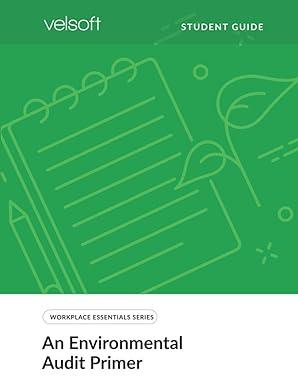Question
Account balances, taken from the ledger of Argot Flooring Ltd. as of 31 December 20X5, appear below: Accounts payable $280,000 Land $ 398,000 Accounts receivable
Account balances, taken from the ledger of Argot Flooring Ltd. as of 31 December 20X5, appear below:
Accounts payable $280,000 Land $ 398,000
Accounts receivable 632,000 General operating expenses 338,000
Accumulated depreciation 42,000 Notes payable 232,000
Allowance for doubtful accounts 3,000 Notes receivable 120,000
Building and equipment 198,000 Property tax expense 3,200
Common shares 204,100 Cost of goods sold 1,042,000 12,400
Dividends declared 80,000 Cash ?
Deferred tax liability 116,700 Retained earnings, 1 January 20X5 806,400
Income tax expense* 334,600 Revenue 2,632,000
Interest revenue 5,000 Salaries expense 232,000
Inventory, 31 December 20X5 480,000 Store supplies inventory 12,400 Unearned revenue 32,000
Additional information:
1. Store supplies were counted at 31 December and found to be valued at $5,600.
2. Depreciation of building and equipment is over eight years with an expected salvage value of $10,000.
3. Property taxes of $3,200 were paid on 1 October 20X5 and relate to the year 1 October 20X5 to 30 September 20X6.
4. The note payable was issued on 1 November 20X5 and has an annual interest rate of 12%. Interest must be paid each 30 October along with $30,000 of principal. Interest payable has not been recorded.
5. The note receivable has been outstanding all year. Interest at 10% is collected each 1 June. The note is due 1 June 20X11. Interest receivable has not been recorded.
6. The allowance for doubtful accounts now has a $3,000 credit balance. Aging of accounts receivable indicates that $76,000 of the accounts are doubtful.
7. Unearned revenue represents an advance payment from a customer; 75% was still unearned at year-end.
8. At year-end, $10,000 (at retail value) of goods was shipped to customers, but the sale was not yet recorded. Correctly, the goods were not included in closing inventory. The revenue must be recorded.
Required: 1. Explain the meaning of GAAP.
2. Identify common objectives of financial reporting.
3. Prepare adjusting journal entries to reflect the additional information provided above.
4. Explain the following (a) through (d), and give an example of an adjusting journal entry in requirement 3 caused by each: a. Time-period assumption b. Continuity assumption c. Accrual concept
5. Prepare a multiple-step classified statement of comprehensive income, a statement of changes in equity, and a classified statement of financial position based on the adjusted accounts. There was no change in the common share account during the year. Use cash as a balancing figure on the SFP.
6. Assume that accounts have changed (after the entries made in requirement 3) as follows over the period:
Accounts receivable (net) $41,900 decrease
Interest receivable no change
Inventory 136,000 increase
Store supplies inventory 8,000 decrease
Prepaid property tax no change
Buildings and equipment 40,000 increase
Accounts payable 75,000 increase
Interest payable 4,640 increase
Notes payable 232,000 increase
Deferred tax liability 26,400 increase
Unearned revenue 24,000 increase
Prepare the operating activities section of the SCF using the indirect method of presentation.
Begin the SCF with net earnings. Include separate disclosure of cash flows on the face of the SCF for interest paid and received and income tax paid.
Step by Step Solution
There are 3 Steps involved in it
Step: 1

Get Instant Access to Expert-Tailored Solutions
See step-by-step solutions with expert insights and AI powered tools for academic success
Step: 2

Step: 3

Ace Your Homework with AI
Get the answers you need in no time with our AI-driven, step-by-step assistance
Get Started


